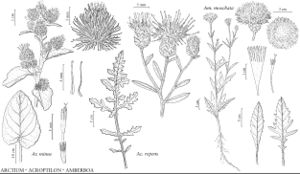Acroptilon
in F. Cuvier, Dict. Sci. Nat. ed. 2, 50: 464. 1827.
| Taxon | Illustrator ⠉ | |
|---|---|---|
 | Arctium minus Acroptilon repens Amberboa moschata | John Myers John Myers John Myers |
Perennials, 30–100 cm, not spiny. Stems erect, branched distally or throughout, branches ascending, not winged. Leaves: basal and proximal cauline; sessile or petiolate; blade margins coarsely dentate or 1–2-pinnately lobed, margins of mid and distal cauline dentate or entire, faces loosely tomentose or glabrate, puberulent and resin-gland-dotted. Heads discoid, in (leafy-bracted) corymbiform or paniculiform arrays. Involucres ovoid to subspheric, constricted, 6–10 mm diam. Phyllaries many in 6–8 series, outer round to ovate, bases tightly appressed, margins entire, apices widely scarious, obtuse or acute, inner lanceolate, margins entire, apices acute to acuminate, those of innermost bristly-ciliate or plumose. Receptacles flat, epaleate, bearing setiform scales (“flattened bristles”). Florets 15–36; corollas blue, pink, or white, tubes very slender, usually bent distally, throats abruptly expanded, lobes linear; anther bases short-tailed, apical appendages oblong; style-branches: fused portions with slightly swollen basal nodes minutely hairy, distally papillate, distinct portions very short, apices triangular. Cypselae obovoid, slightly compressed, smooth or with indistinct ribs, glabrous, attachment scars subbasal; pappi ± falling, of many unequal setiform scales (“flattened bristles”), proximally barbed, distally plumose (at least the longer). x = 13.
Distribution
Introduced; Eurasia
Discussion
Species 1.
In most American floristic literature Acroptilon has been included within Centaurea, from which it differs by the subbasal rather than lateral attachment scars on the cypselae and the absence of sterile outer florets. The chromosome base number x = 13 is higher than that in most species of Centaurea in the strict sense. Molecular phylogenetic studies of the relationships of Cynareae genera (A. Susanna et al. 1995) support the segregation of Acroptilon from Centaurea.
Selected References
Lower Taxa
"fine" is not a number.